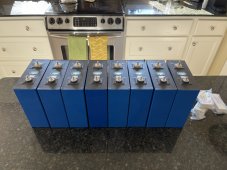Hey everyone,
Thought I’d post yet another “received my cells” thread because I have a question about balancing. Cells arrived in undamaged boxes and at first glance looked darn good. I got to planning the build out the other day and noticed two things, slight bulging with all cells and a slight indentation. I hope it comes through in the pictures.
I understanding the bulging is a regular occurrence with many reporting the same thing on arrival. The first question I have is about balancing. Do I compress and top balance or do I top balance, drain them through a capacity test to remove the bulges, compress then top balance again? Not sure if compressing with the bulge will damage them.
Second question is about the dent. Voltage checks out perfectly aligned to the other cells at 3.27. Just looking for some moral support to proceed amd not let the OCD overwhelm me.
Thought I’d post yet another “received my cells” thread because I have a question about balancing. Cells arrived in undamaged boxes and at first glance looked darn good. I got to planning the build out the other day and noticed two things, slight bulging with all cells and a slight indentation. I hope it comes through in the pictures.
I understanding the bulging is a regular occurrence with many reporting the same thing on arrival. The first question I have is about balancing. Do I compress and top balance or do I top balance, drain them through a capacity test to remove the bulges, compress then top balance again? Not sure if compressing with the bulge will damage them.
Second question is about the dent. Voltage checks out perfectly aligned to the other cells at 3.27. Just looking for some moral support to proceed amd not let the OCD overwhelm me.





